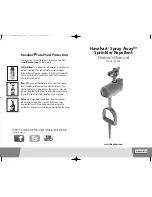
Installation Instructions
Residential Reverse Osmosis Drinking Water System
Page 17
Flushing system and checking operation
To make sure RO system is operating correctly, follow these
simple procedures:
1. Open faucet handle and allow tank to completely drain
(water will be discolored and will have suds from the
sanitizing solution).
2. Close faucet and re-fill the system.
3. Allow system to process water for approximately 2-3
hours, at which point tank will be practically full.
4. Open faucet again and allow tank to empty for a second
time. Do not use this water.
5.
Wait another 2-3 hours to allow tank to re-fill.
Air Purging
If the tank doesn’t fill, the tank tubing may have air in it.
Typically the standard startup procedure will be sufficient but in
some cases due to the water temperature and pressure,
additional air bleeding must be performed. The following
procedure will help bleed air from the system.
1. Close the tank valve and the feed water valve and open
the faucet to relieve the pressure on the system.
2. Remove the tank tubing from the tank valve and hold it
over a bucket or pan.
3. Open the feed water valve and the faucet.
4. Allow the system to run until there is a stream of water
coming from the tank tubing.
5. Once there is a steady stream coming from the tank
tubing, push it back into the tank valve. BE SURE to push
it in the tank valve completely or a leak could occur.
6. Allow the system to continue to operate until there is a
steady stream coming from the faucet.
7. Once there is a steady stream coming from the faucet,
close the faucet and open the tank valve. Then go to the
flushing procedure above.
NOTE: If no objectionable tastes are noticed after second tank
draining, RO processed water is ready for use. Otherwise, drain
tank and re-fill for a third time.
At this point supply line to ice maker connection (optional) may
be opened.
Why the regular use of Sani-System is important.
A reverse osmosis system should be sanitized regularly to
maintain quality service levels. If the system is not properly
maintained, bacteria can begin to grow and multiply
wherever the water sits, including on the inside surfaces of
tanks and hoses. Filling the system with impure water can
also be a cause, but over time, bacteria grows — even in
chlorinated water. When water sits in a tank or hose,
chlorine levels drop, reducing its chemical ability to prevent
bacterial growth. Filters can also filter out chlorine, making
the water more susceptible to bacterial growth. In addition,
system equipment such as hoses, filters and canisters can
harbor and help to support bacterial growth.
Sani-System is the only EPA & NSF approved sanitizer for
use in reverse osmosis units. It is proven to kill 99.9% of
harmful bacteria without the use of chlorine, oxidizers or
acids that can harm system parts. Sani-System maintains
the performance of your reverse osmosis system and
restores it to peak efficiency.
Содержание Aquapurion 200-APRO Series
Страница 20: ...Installation Instructions Residential Reverse Osmosis Drinking Water System Page 20 Green Tube ...
Страница 21: ...Installation Instructions Residential Reverse Osmosis Drinking Water System Page 21 Green Tube ...
Страница 23: ...Installation Instructions Residential Reverse Osmosis Drinking Water System Page 23 ...








































